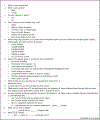Self-Reported Changes and Perceived Barriers to Healthy Eating and Physical Activity among Global Breast Cancer Survivors: Results from an Exploratory Online Novel Survey
- PMID: 33109503
- PMCID: PMC11217928
- DOI: 10.1016/j.jand.2020.09.031
Self-Reported Changes and Perceived Barriers to Healthy Eating and Physical Activity among Global Breast Cancer Survivors: Results from an Exploratory Online Novel Survey
Abstract
Background: Despite being motivated to improve nutrition and physical activity behaviors, cancer survivors are still burdened by suboptimal dietary intake and low levels of physical activity.
Objective: The aim of this study was to assess changes in nutrition and physical activity behaviors after cancer diagnosis or treatment, barriers to eating a healthy diet and staying physically active, and sources for seeking nutrition advice reported by breast cancer survivors.
Design: This was a cross-sectional study.
Participants/setting: The study included 315 survivors of breast cancer who were recruited through social media and provided completed responses to an online exploratory survey.
Main outcome measures: Self-reported changes in nutrition and physical activity behaviors after cancer diagnosis or treatment, perceived barriers to healthy eating and physical activity, and sources of nutrition advice were measured.
Statistical analysis: Frequency distribution of nutrition and physical activity behaviors and changes, barriers to healthy eating and physical activity, and sources of nutrition advice were estimated.
Results: About 84.4% of the breast cancer survivors reported at least 1 positive behavior for improving nutrition and physical activity after cancer diagnosis or treatment. Fatigue was the top barrier to both making healthy food choices (72.1%) and staying physically active (65.7%), followed by stress (69.5%) and treatment-related changes in eating habits (eg, change in tastes, loss of appetite, and craving unhealthy food) (31.4% to 48.6%) as barriers to healthy eating, and pain or discomfort (53.7%) as barriers to being physically active. Internet search (74.9%) was the primary source for seeking nutrition advice. Fewer than half reported seeking nutrition advice from health care providers.
Conclusions: Despite making positive changes in nutrition and physical activity behaviors after cancer diagnosis or treatment, breast cancer survivors experience treatment-related barriers to eating a healthy diet and staying physically active. Our results reinforce the need for developing tailored intervention programs and integrating nutrition into oncology care.
Keywords: Barriers; Cancer survivors; Lifestyle; Nutrition; Physical activity.
Copyright © 2021 Academy of Nutrition and Dietetics. Published by Elsevier Inc. All rights reserved.
Conflict of interest statement
STATEMENT OF POTENTIAL CONFLICT OF INTEREST
No potential conflict of interest was reported by the authors.
Figures






Similar articles
-
Exploring tensions within young breast cancer survivors' physical activity, nutrition and weight management beliefs and practices.Disabil Rehabil. 2020 Mar;42(5):685-691. doi: 10.1080/09638288.2018.1506512. Epub 2019 Jan 7. Disabil Rehabil. 2020. PMID: 30616419
-
Evaluation of Diet Quality Among American Adult Cancer Survivors: Results From 2005-2016 National Health and Nutrition Examination Survey.J Acad Nutr Diet. 2021 Feb;121(2):217-232. doi: 10.1016/j.jand.2020.08.086. Epub 2020 Nov 3. J Acad Nutr Diet. 2021. PMID: 33158797
-
The Role of Social Media Advertisement and Physical Activity on Eating Behaviors among the General Population in Saudi Arabia.Nutrients. 2024 Apr 19;16(8):1215. doi: 10.3390/nu16081215. Nutrients. 2024. PMID: 38674905 Free PMC article.
-
Dietary Habits of Young Poles and Their Selected Determinants: A Review and Implications for Public Health.Nutrients. 2024 Oct 21;16(20):3561. doi: 10.3390/nu16203561. Nutrients. 2024. PMID: 39458555 Free PMC article. Review.
-
Diet and Physical Activity Behaviors of Breast Cancer Survivors: A Scoping Review.Semin Oncol Nurs. 2025 Feb;41(1):151763. doi: 10.1016/j.soncn.2024.151763. Epub 2024 Dec 9. Semin Oncol Nurs. 2025. PMID: 39658462
Cited by
-
Results of the ECHO (Eating habits CHanges in Oncologic patients) Survey: An Italian Cross-Sectional Multicentric Study to Explore Dietary Changes and Dietary Supplement Use, in Breast Cancer Survivors.Front Oncol. 2021 Nov 1;11:705927. doi: 10.3389/fonc.2021.705927. eCollection 2021. Front Oncol. 2021. PMID: 34804915 Free PMC article.
-
Perceptions of Older Adults with Hematological Cancer on Diet and Exercise Behavior and Its Role in Navigating Daily Tasks.Int J Environ Res Public Health. 2022 Nov 15;19(22):15044. doi: 10.3390/ijerph192215044. Int J Environ Res Public Health. 2022. PMID: 36429764 Free PMC article.
-
Health-related quality of life among cancer survivors: pre-existing chronic conditions are to be given priority.Support Care Cancer. 2024 Jan 22;32(2):124. doi: 10.1007/s00520-024-08315-7. Support Care Cancer. 2024. PMID: 38252273
-
Optimizing Fertility Treatment With Nutrition Guidance: Exploring Barriers and Facilitators to Healthful Nutrition Among Female Cancer Survivors With Fertility Challenges.Integr Cancer Ther. 2023 Jan-Dec;22:15347354231191984. doi: 10.1177/15347354231191984. Integr Cancer Ther. 2023. PMID: 37559460 Free PMC article.
-
Cancer survivors' adherence to the American cancer society and American institute of cancer research dietary guidelines in Lebanon.BMC Public Health. 2024 Oct 8;24(1):2738. doi: 10.1186/s12889-024-20099-3. BMC Public Health. 2024. PMID: 39379867 Free PMC article.
References
Publication types
MeSH terms
Grants and funding
LinkOut - more resources
Full Text Sources
Other Literature Sources
Medical

